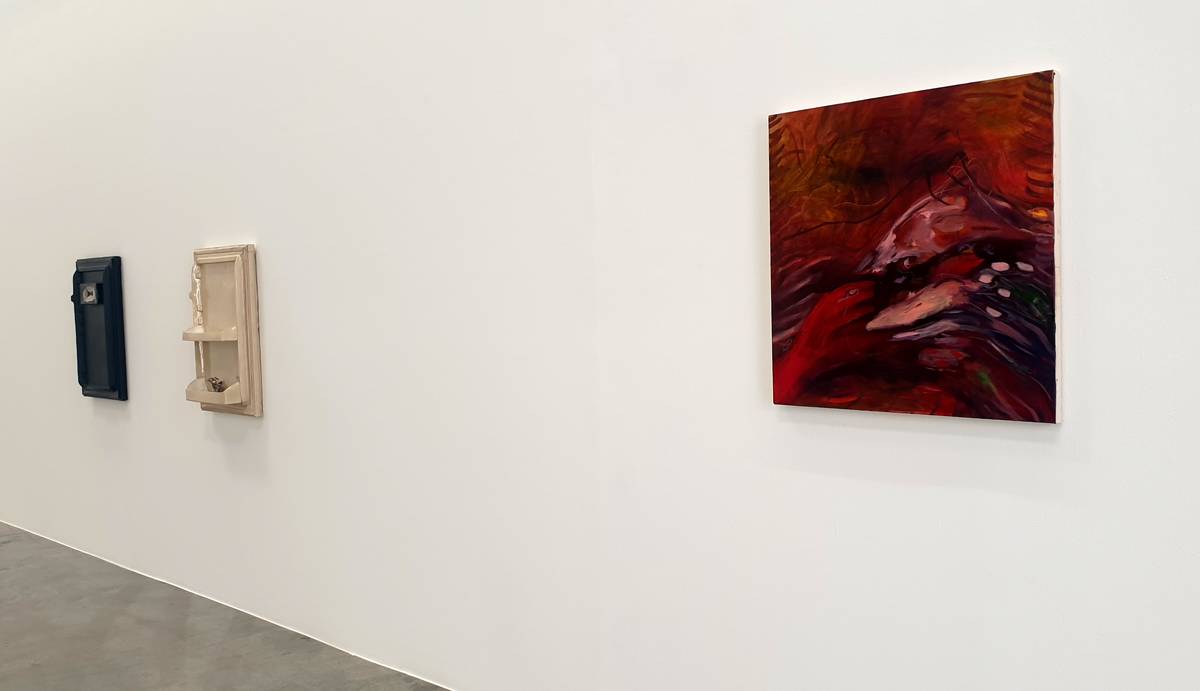
The strange Four am by Grabuschnigg and Malas at Carbon 12 Gallery, Dubai
Two women artist showed very strange story of four am at carbon 12 gallery in Alserkal Avenue Dubai. Monika Grabuschnigg (German)& Nour Malas (Syrian Canadian)
Artdayme: Monika Grabuschnigg & Nour Malas showed strange four am in format of painting and sculpture.
Duo Exhibition continues till 7 September.
Kourosh Nouri and Nadine Knotzer, the founders and managers of Carbon 12 Gallery.
The gallery is written statement for introducing exhibition : Monika Grabuschnigg's (Vorarlberg, 1987) sculptures and installations process her own understanding of some tragic innermost core of human life: our being, the horizon of death, deep valleys of tears in between, while Nour Malas's (Cannes, 1995) paintings, produced during a period of grief and celebration, take as their subject the space between the two completely opposing emotional states.
Nour Malas having called several places home, Nour Malas attempts to find comfort in the mundane. A Syrian Canadianartist, Malas is currently based in Chicago where she completed her MFA in sculpture at SAIC. She had previously received her BFA from Goldsmiths University in London. Having also grown up in the United Arab Emirates, Malas’s practice is influenced by the multiple cities and cultures that were part of her upbringing.Malas’s work has appeared in severalgroup exhibitions in Chicago, Dubai, London, and Greece. Her first solo exhibition ‘Desperately Continuous Bodies’took place in Thessaloniki, Greece in 2019Born in 1995, Cannes, FranceLives and works in Chicago Illinois
The strange four am by two artists
MONIKA GRABUSCHNIGG & NOUR MALAS four am is a monstrous kind of time. The mark of an emergency, a twilight framed by two unstable boundaries. One is the ‘Witching Hour’
. Though not everyone agrees about what precise time of night this is, all agree it’s when all sorts of ghosts and ghoulsand lurid apparitions stalk the human heart, curdling our blood when we’re met by seeable frights. Some say it’s the hour after midnight; others, between three and four AM. Then there's the dawn, itself a transitional stage on a seasonally variable schedule, the prelude to the screaming birds at sunrise.
Few people see this time. It’s mostly for the unluckily sleepless, the anxious, the troubled. Perhaps our contented eyelids get heavy as we wait for night to fall, to save us from the day. Perhaps we sleep, propelled with hopes of future freshness. Monsters come when that fails. They tread heavy but unhurried through the crushing dark. We can only see them if other conditions are met, things outside our control. They can only be caught in glimpses, flashes. Light beyond the window is one. Maybe they’re better seen in cities. There’s little point in lying in bed at this time. These days, of course, we have a whole army of sleek and shiny technological devices to distract us. With these temporary entertainments, enjoyed for a moment, silent and lonely in the black, we no longer have to spend the night tossing and turning. But sometimes our concentration fails.
A solution: we can get out of bed and shuffle along through the demigloom; we feel our flesh against shining laminate, creaking parquet, the cold promise of kitchen tiles, aware of dryness, calluses, the sensory tint of years of stress and activity. Andwe can open the fridge, bathed in synthetic luminous doom. Monika Grabuschnigg's (Vorarlberg, 1987) sculptures and installations process her own understanding of some tragic innermost core of human life: our being, the horizon of death, deep valleys of tears in between. These ceramic fridge doors openup new, uncharted realms of sadness, prinked by desires we never knew we had. Time is fleeting. Our lives are short. We must do what we can. These works attempt to preserve this sense of ourselves, delaying our decay.
Featuring casts of everyday utensils,the sculptures remind us of functional artefacts, plunging into deep melancholy and loneliness. They are complemented by drawings of hanging floral arrangements with lush satin bows, the atmosphere of the memento mori, witnesses to their own withering, preemptively grieving for themselves, for all of us.
The paintings of Nour Malas (Cannes, 1995), produced during a period of grief and celebration, take as their subject the space between the two completely opposing emotional states. They complement each other without ignoring their own contradictions. Her approach relies on the immediacy of painting, how the possibility of frenetic self-expression rears up from memories, from points of free association that live inside her: forms and faces remembered in the head, the heart, the spaces between us. These puzzling emotional landscapes are maps of placelessness, orders of nonlinearity, full registers of the abundance of loss.
Grabuschnigg and Malas don’t just share a set of preset personal responses that can be turned on and off at will. Their approaches didn’t come about by pure coincidence or magic. Rather, it all comes from inside them, indexed to all sorts of other impulses that we all see and feel even if we don’t respond to them like this or make art ourselves: monsters in the ultra-early morning, the shuddering moment between tearful gasps, the time spent waiting unredeemed for dawn, deafened by the birds as the sun rears its merciless head.
Duo Exhibition continues till 7 September. Interested can visit duo exhibition at carbon 12 gallery Dubai at unit 37 , Alserkal Avenue.




















LEAVE A RELPY